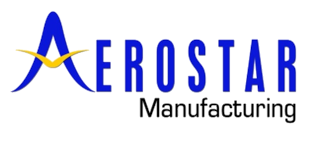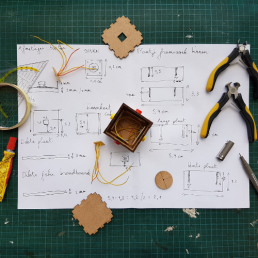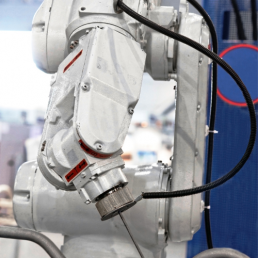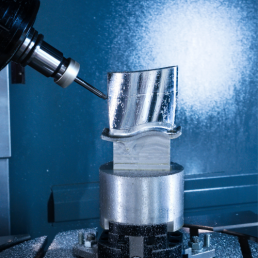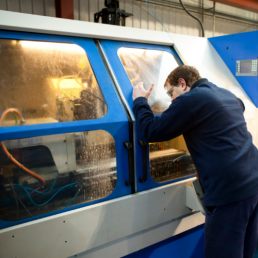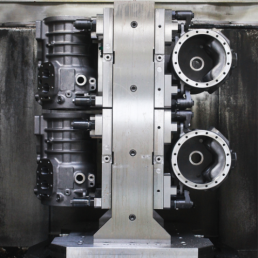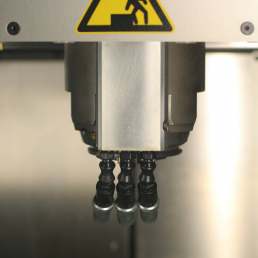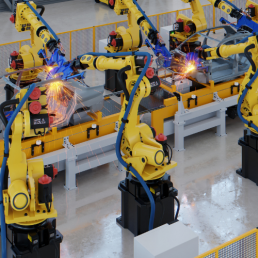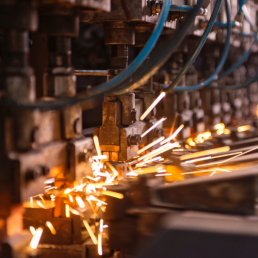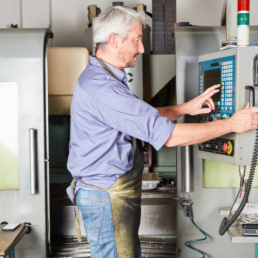Prototype Machining: How Is It Used in the Automotive Industry?
How exactly is prototype machining used in the automotive industry?
According to Business Opportunities:
At What Prototyping Stages Is Machining Efficient?
The automotive industry is highly competitive. For example, a deadline for a new auto to be designed and brought to market is two to four years. That is a very short amount of time for a product of such complexity to be designed, prototyped, tested, and brought into mass production.
In order to achieve such urgent deadlines, the CEO’s of automotive companies try to shorten each of the stages. In this post, we’re talking about the prototyping stage. Specifically, we’ll address the way prototype machining helps shorten the prototyping and testing stages. Ultimately, shortening these stages will increase company competitiveness and success in the market.
Machining for Concept Prototypes
Proof-of-concept is one of the first major prototyping stages. It is at this stage that designers work with a small mockup of the future auto. The designers might create this mockup manually using softer materials. For example, they might carve it from wood or mold it with clay. Softer materials ensure easy modifications at this early stage.
However, these materials are only useful when designers are working with the enclosure of the car. When they’re designing functional parts, though, clay or wood might not be an option.
For example, if the designer wants to design a new pumping system, aluminum or steel will be necessary, since pumping systems work under high pressure.
CNC Machining
Therefore, manufacturing such parts with CNC (“computer numerical control“) machining is the only option. Moreover, the parts at this stage are quite crude, and there will only be a few of them that will need CNC machining. That’s because designers usually try to combine standard parts into the mechanism to minimize the price of the prototype.
Prototype Machining at the Design Validation Stage
Developers manufacture the next serious prototype much later, once the design has been set in stone. This is the design validation prototype.
Developers intend at this stage to determine whether the parts they have invented, as well as the overall structure of the mechanism, can be realized.
Often, what happens is that some parts can’t be manufactured or assembled because of geometry imperfections. Moreover, because they’re not concerned about the functionality of the product at this stage, developers often use soft materials.
For example, they might use plastic models to create design validation prototypes. For these models, machining is a good option. However, 3D-printing can yield similar results more quickly.
Pre-Development Prototype Machining
Once developers are sure that the idea works and they have verified the mechanism’s geometry, it’s time to test the functionality of the car and its various parts.
Generally speaking, even if the whole car has been designed, its separate parts are manufactured and mounted on other car models for testing. This method makes it easier for developers to isolate the newly developed mechanism and look at the way it performs.
The Manufactured Prototype
The properties of the manufactured prototype must be quite close to those of the intended final product. Therefore, developers use materials that will be used in the actual car. Mostly, these are steel and aluminum alloys.
However, the initial blanks for these prototypes are standard ones. In contrast, mass-produced cars usually require precise specialized blanks. That’s because more precise blanks decrease waste.
This is the stage where rapid CNC machining truly shines. That’s because this method machines the standard blanks to the form of the prototype that the designers have in mind.
Production Process Validation Prototyping
When it’s time for the validation prototyping, the design has been long validated. Moreover, developers have also validated its performance as well.
Next comes the manufacturing process for mass-production. However, even with all that has come before it, developers must tweak and test this stage, too.
For example, they will carefully verify the tooling and manufacturing methods. This is important, as these methods will affect the final price of the car.
Test Runs with Mass Production
Therefore, manufacturers do a number of test runs with the mass production methods. In this way, they produce production process validation prototypes.
Basically, the prototypes serve as test results at this stage. Machining doesn’t play a central role anymore. However, it takes up its niche, and the niche is quite large.
For example, almost every part of the auto is machined to some degree. That’s because a good surface finish is important. Also, automobiles require a very close tolerance. Basically, machining is one of the finishing processes, along with grinding.
Customer Testing Prototype
Customer testing prototypes are basically the same as production process validation prototypes in terms of their structure. That is, both look like the final product.
However, the customer testing cars have multiple sensors mounted on them. These sensors monitor the condition of the car as well as the way the driver reacts in different situations. This helps manufacturers determine any possible flaws.
Safety Test Prototypes
Safety testing is basically the same as customer testing. However, there is a big difference: The safety testing prototype will be ruined by the end of the tests.
That’s the point of safety testing, after all. Engineers cause the car to crash in a lot of different ways. Then they look at the condition of the driver mannequin and the car itself.
Why Is Machining a Good Option?
By using the CNC turning and milling processes, specialists can manufacture more than 90% of the parts the modern automotive industry now uses.
Why are these methods so useful to designers and developers? Basically, it’s because specialists can manufacture complex parts from even the hardest of metals.
For example, modern CNC machine tools, in conjunction with modern cutters, can take up almost any challenge in hardness and tensile strength. Moreover, these tools make parts of outstanding quality.
How Prototype Machining Services Can Help Automotive Companies
The facilities of many automotive companies are highly specialized for mass production. This means that their equipment is efficient at manufacturing one type of part. On the other hand, it also means that their equipment is not flexible at all.
That’s why CNC machining prototype services are becoming more and more popular with automobile manufacturers. That is, manufacturers can outsource the designs for their cars to specialists. These specialists then provide them with prototype machined parts and assembled mechanisms.
This saves time for manufacturers. That’s because they don’t need to set up equipment for the earlier stage prototypes. Instead, they can leave the CNC prototyping to the people who specialize in it.
What’s more, these specialists will make those prototypes faster and cheaper than the manufacturers could have.
Automation for Low Volume, High Mix Production
Automation is changing production in many ways.
According to Modern Machine Shop:
Whether in a production job shop or other high mix manufacturer, many machine shop managers think their automation options are limited due to all the variability of their parts that are run in relatively small lots. Some shops have turned to standard horizontal machining centers to achieve better spindle utilization, machine multiple jobs in a cycle, and run unattended for limited periods. But sooner or later having just two pallets to work with proves limiting in maximizing the return on a horizontal machining center.
The good news is that standardized automation systems are available that allow machine shops to bring more pallets into the fold to expand capacity even for small runs, retain flexibility, and achieve production efficiencies comparable to high-volume production machining.
This is a specialty of well-known machine tool builder Makino. You may think of Makino’s automation capabilities more in terms of large high-volume applications, but they also focus on standardized options that are scalable to shops and lots of almost any size. A good example is the MMC2 Flexible Manufacturing System. It’s a too simple to call the MMC2 bolt-on automation, but it does indeed provide a standardized approach to automatic machine loading/unloading in customizable and reconfigurable layouts. A number of job shops use the system, a few of which you can view in the videos here.
A Pallet is a Pallet
If automated cellular manufacturing still sounds like a leap of technology for an average shop, let’s break it down to the basics. Most shops doing production work are familiar with multiple part fixtures, and if they are using horizontals, mounting those fixtures on a tombstone. By using all four sides of the tombstone you can machine multiple different parts in a single cycle or three sides of a single part. You set up the fixture, establish the workholder/workpiece offsets and run until all the parts are machined. But once that cycle is done, you better have the next pallet of parts ready, or you are losing precious cutting time on an expensive machine. This keeps operators tied more closely to each machine, and still limits the amount of production that can be accomplished in a workday.
Having more pallets to work with alleviates these constraints. You still load fixtures and parts on a pallet like you did before, but now those pallets can be stored in a cue and automatically moved in and out of a machining center on demand. Because all the pallets in the cell are completely interchangeable, establishing location within the machine is the same as with a standalone machine. The variability of different parts is managed on top of the pallet, while loading and unloading of pallets is completely standardized. This even works with different machining centers (all HMCs in the Makino’s 1 Series line) that use the same pallet design.
Configuring the System
The core of a basic MMC2 machining cell is still a horizontal machining center. However, now pallets are stored on a stocker rail or multi-level stand that is serviced by a rail guided vehicle that picks up pallets and delivers them to and from the machine. Pallets are set up at a work setting station which is also serviced by the vehicle. The more centralized loading station makes better use of operator time and It opens up opportunities to do other things, such as gaging or other QC functions.
While that’s all straightforward enough, the key to making it all work in a truly automated fashion is managing the workflow in and out of the cell as well as tracking other process variables such as workholder and cutting tool offsets, useable tooling inventory in the HMC, part programs and other process data. This is all handled by the MAS-A5 Cell Controller that is pre-integrated with the system. More on this below.
What’s particularly helpful in a high mix environment is how easy it is to configure the cell to serve a shop’s individual requirements. You can start small, say with a single machine, six pallets and a single work setting station. Then more capacity can be added later as needed, including more machining centers (up to 15), up to four worksetting stations, and 200 pallets, but all still under a single cell control. This allows the cell to grow with your needs. Once many shops become familiar with how manageable this technology can be, they tend to find more parts to machine this way. Moreover, this capability can enable shops to increase their ability to serve customers both with greater efficiency and responsiveness.
Growing with the Business
New Dimensions Precision Machining is a great example of how this technology was able to grow with the business and help grow the business. According to Director of Business Development, Martin Halwix, (see video) New Dimensions grew up as a typical shop that did some high-volume work plus the familiar job shop mix of small lot jobs. As the business has grown, however, it created opportunities to automate. And conversely, their ability to use automated systems has been a major enabler to capturing new business. The latter is because of how automation has enabled New Dimensions to serve customers’ increasing demands for flexibility without increasing costs. Says Halwix, “With the industry changing and customers not wanting to commit to inventory, and not forecasting part usage, you have to be able to produce parts on demand. (Customers want) no excess inventory and you have to be able to do it economically.”
If you’re wondering how a job shop can afford all this automation, especially for low-run, high-mix work, here’s Halwix’s answer: In comparing the economics of New Dimensions’ current automated methodologies to their past production methods he says they can produce the same lot sizes with 70% less labor content. And they can deliver parts as quickly, or quicker, than they were able to in the past.
Keeping it All Under Control
Most automation veterans will tell you it’s often the little things that create the biggest headaches. How do you know you have the right tooling in the machine? How do you know you are using the latest version of a part program? How do you know you have the right fixture ready for the part? These and other reasons are why the cell control is so critical to the success to the MMC2 system.
To be sure, automation will force a job shop to change its process on how it prepares to run a job. The most challenging aspect of introducing automation to a traditional job shop environment can be affecting the cultural change necessary for employees to embrace a new way of working. For the skilled machinist who is accustomed to doing everything – from setup to tool management to adjusting machining parameters to inspection – a more automated approach will have a big impact on that job. Rather than one person controlling virtually all aspects of the machining process you will move to having dedicated areas of the shop for functions such as loading parts on pallets properly with work offsets established outside the machine or presetting tools with people who are skilled in those specific tasks. But once these changes are made, the cell control becomes the hub where all of this critical process information is managed.
Management functions handled by the MAS-A5 cell controller include:
- Production order management relating orders to part runs
- Dynamic workflow scheduling to maximize spindle utilization while still meeting job due dates and production priorities
- System resource management such as logging tools and fixtures in and out of the cell
- Part program management with version control
- Connectivity between the MMC2 system and the shop network
For example, if a job is scheduled to run, the cell control will check to see that the proper fixture is mounted on a pallet in the system and loaded with parts. It will even display detailed work instructions for each fixture on the pallet to assist setup and manage part status, clamp and unclamp quantities and overall fixture or pallet status to ensure a job is ready before it is placed in the work cue.
Before a pallet is sent to a machine the cell control will also check to see if the necessary tools are loaded in the machine carousel and with sufficient life to finish the job. When a tool reaches its programmed life it will finish the part and then be automatically replaced with a redundant tool if one is available. It will also access the part program archive and load the correct program into the machine CNC.
Other tool management functions are enabled such as checking tools in and out of the system, and connecting to a “virtual tool crib” to see if needed tools are available, but not yet loaded into the system. It can also connect to a tool presetter so that tool offset data is automatically transferred to the machine CNC.
Reliability is Essential
A significant risk to relying on fully automated machining is that you do have a lot of eggs in one basket and the predictability and reliability of the system is critical. This is a particular emphasis point with Makino, both in how they design machines for reliable performance in high cycle production and in how they provide service support when a need emerges. Makino has installed some 750 linear pallet pools across North America and typically can arrive at a site the same or next day. They provide local operations training and can also support the system remotely via a network connection to troubleshoot problems or execute software updates.
Is this kind of automation for any shop? Not necessarily, but for shops doing production work with repeating orders, automation systems such as horizontal machining centers serviced by the MMC2 pallet handing system are increasingly driving cost and flexibility expectations higher in the high-mix, low volume parts machining market. If that sounds like your shop, it’s time to investigate what this technology can do for your business.
Machining Market to Reach $414.17 Billion by 2022
The machining market is expected to see growth.
According to PR Newswire:
The global machining market is currently estimated to be worth $341.91 billion and is growing at a CAGR of 6-7 percent till 2022, according to Beroe Inc., a procurement intelligence firm. Precision machining holds a market size of 70 percent, with conventional machining having 30 percent. Increasing demand from end-use sectors, like the automotive and electrical industries, is driving the market growth.
The Asia Pacific is considered the largest demand region for the machining market, with a global market share of 35 percent, followed by Europe with 25 percent, North America with 21 percent, Latin America with 10 percent and the MEA with 9percent. China has the largest market for machining, estimated to be worth $54.71 billion and growing at an annual rate of 6.6 percent.
The automotive and transportation industry accounts for 30-32 percent of the demand for machining, growing at a rate of 7-8 percent, followed by the electrical/electronics industry for 16-17 of the demand, growing at 4-7 percent. Lack of viable substitutes coupled with extensive demand from end-user segments is driving the growth of the machining market. Shortage of suitable labor, global economic recovery, and fluctuations in commodity prices affecting raw material costs are major constraints faced by the market.
Milling, turning, drilling, grinding and cutting are some of the key machining techniques, where CNC or conventional machines are using widely to perform the process. In the coming years, more conventional machines will be replaced by CNC technology to improve output and precision, owing to the stringent requirement from the end-user. The milling machines segment is expected to grow at a CAGR of 8-9 percent owing to features such as multi-functionality and reduction in setup time.
Key Findings:
- The 5-axis machine tools have created a huge difference in the machining market by increasing efficiency, reducing cycle time, and reducing material wastage. These kinds of innovations in machine tools are further expected to drive the machining market.
- Labor cost plays a vital role in the determination of the overall cost structure depending on the skill set involved, the complexity of the end product. Regional price differences on labor rates and power can play a crucial factor for sourcing decisions
- The global machining industry is highly fragmented and comprises of several small and medium-scale enterprises that offer their services. The supplier base is fragmented for machining due to which the buyer can bargain to reduce costs.
- The present technological substitutes like 3D printing and additive manufacturing offer reduction of lead time and less waste, they are yet to be made commercially viable. Lack of viable substitutes are expected to sustain the machining market in the short-term.
- Even though the profit margin is 10–15 percent, given the current economical situation, it is very difficult to maintain the profit percentage, since the machining work decreased and the suppliers were forced by the customer to reduce the prices.
The research methodology adopted for the report included:
- Experts with twenty years of domain experience
- Interaction with buyers
- Inputs from supply chain partners
Materials represent approximately 37 percent of the total costs, followed by labor for 39 percent, energy for 19 percent and overheads for 4 percent. The cost and proportion of input materials for machining differ based on the type of metal to be machined and the commodity cost fluctuations which are generally passed on to the customers. Design and complexity of the product, wastages, material availability/cost by region are other key factors influencing the cost structure.
The report also includes:
Market Analysis:
- Industry Classification
- Global Market Overview
- Key End-user Industry
- Global Market Maturity
Regional Market Analysis:
- US
- China
- Germany
- Japan
- India
Industry Analysis:
- Porter's Five Force Analysis
- Drivers and Constraints
Cost Analysis:
- Cost Structure Analysis
- Commodities Price Trend
Supplier Analysis:
- Supplier Profiles
Industry Practices:
- Industry Practices
- Value Chain
- Emerging Trends
What Are the Most Popular CNC Machining Trends?
According to Design ideas for the Built World:
1. Growing Use of Five- and Six-Axis Machines
Five-axis machines continue to become more compact and cost-effective, enabling many small manufacturers to take advantage of the more efficient CNC technology.
At the same time, six-axis machines, which arrived on the market in 2019, are also becoming more practical and popular. They provide additional axes of freedom over more conventional but simpler three-axis models.
The amount of time saved can be significant. According to one estimate, six-axis machines may help cut production time by as much as 75% on average. This allows them to improve manufacturing speed and efficiency, as well as help manufacturers mill more complex shapes without removing and adjusting the part being worked on.
2. Greater Accessibility of CAD/CAM Software
Over the past 10 years, the computer-aided design, modeling and simulation technology landscape has become increasingly democratized.
CAD/CAM software is more accessible than ever. It’s available at lower prices, and developers of these tools are making user-friendliness a higher priority. There is also a growing community of programmers and designers working to make the technology as accessible as possible.
The increasing power of computers and availability of cloud computing resources also means that, despite the high amount of computing power CAD/CAM software can require, designers don’t necessarily need high-powered computers to design parts for CNC machining. These tools, combined with other productivity-boosting strategies, can make CNC machines more efficient and improve returns for designers.
Computer-aided design’s increased accessibility could unlock powerful new benefits for small businesses and individual designers, who may have had to enlist the help of larger manufacturers in the past.
These changes are also part of a broader trend in the computer-aided engineering ecosystem. Simulation, finite element analysis (FEA) and computational fluid dynamics (CFD) software are also increasingly accessible to small businesses and individual designers.
3. Manufacturing-as-a-Service (MaaS) Becomes More Popular
With manufacturing-as-a-service, businesses that need production capacity but don’t want to do it in-house subscribe to a service offered by a central manufacturer. It typically owns a range of equipment, like 3D printers and CNC machines. With this approach, the subscriber only pays for the manufacturing capacity they need as they need it — helping to streamline the process and reduce associated costs.
MaaS provides subscribers with access to a wider range of tools, machines and manufacturing equipment, helping them become more agile and productive. MaaS can also serve as a backup to conventional, in-house manufacturing, offering resiliency against supply chain shortages and downtime caused by repairs or machine failure.
As small sector demand for manufacturing grows, MaaS will likely be essential in meeting emerging needs.
4. New Robotics Innovations
Collaborative robotics, a new approach to robot design that emerged in the late 2010s, may help manufacturers adjust to the growing labor gap and increased demand.
These cobots are built with safety features, like padded joints and force limiters, that make them safer for human workers. Unlike conventional robotics, they may not need a cage or similar precautions.
Because cobots are also generally lightweight and easy to reprogram, they can be quickly moved and repurposed for tasks as needed. This makes them a good fit for manufacturers that prioritize agility and flexibility in their workflows.
5. The IloT and Networked CNC Machines
New Industrial Internet of Things (IIoT) devices make it much easier for manufacturers to network CNC machines and other manufacturing equipment. These devices, which use the internet to send and receive data, can enable a range of new features for CNC machines — like remote monitoring of operations.
One popular application is predictive maintenance. With this approach, manufacturers use IIoT sensors to track the operational parameters of their CNC machines. Over time, it is possible to use gathered performance data to create predictive models that forecast when a device will fail or need maintenance.
This approach can help manufacturers improve on their standard preventive maintenance schedule. Typically, it will extend the lifespan of CNC machines and provide significant cost-savings on maintenance.
How CNC Technology Will Change Manufacturing
New challenges for manufacturers will likely spur innovation in CNC machining over the next few years. Six-axis CNC machines, computer-assisted design software and collaborative CNC robotics may help smaller companies improve productivity and stay competitive. At the same time, the growth of small-sector demand may drive new business models, like manufacturing-as-a-service.
These trends reflect current market needs and help manufacturers stay ahead of the curve.
CNC Machine Tools Market 2022
Curious about the future of the CNC Machine market?
According to MarketWatch:
CNC machine tools are automated conventional machine tools in which the motion and function are controlled by means of a computer. The computer executes machine control commands to perform machining on a workpiece. This facilitates the production of identical parts in high volumes without compromising on quality. CNC machine tools are broadly classified into CNC lathe machines, CNC milling machines, and others on the basis of operation.
The CNC Machine Tools market revenue was Million USD in 2016, grew to Million USD in 2021, and will reach Million USD in 2026, with a CAGR of during 2021-2026.
Considering the influence of COVID-19 on the global CNC Machine Tools market, this report analyzed the impact from both global and regional perspectives. From production end to consumption end in regions such as North America, Europe, China, and Japan, the report put emphasis on analysis of market under COVID-19 and corresponding response policy in different regions.
This report also analyzes the strategies for different companies to deal with the impact of COVID-19 in detail to seek a path to recovery.
Under COVID-19 Outbreak, how the CNC Machine Tools Industry will develop is also analyzed in detail in Chapter 1.8 of this report.
Final Report will add the analysis of the impact of COVID-19 on this industry.
TO UNDERSTAND HOW COVID-19 IMPACT IS COVERED IN THIS REPORT - REQUEST SAMPLE
This report provides a detailed evaluation of the market by highlighting information on different aspects which include drivers, restraints, opportunities, threats, and global markets including progress trends, competitive landscape analysis, and key regions expansion status. This report is comprehensive numerical analyses of the CNC Machine Tools industry analysis and provides data for making strategies to increase the market growth and success. The Report also estimates the market size, Price, Revenue, Gross Margin and Market Share, cost structure and growth rate for decision making.
CNC Machine Tools Market size provides key analysis on the market status of the CNC Machine Tools manufacturers with best facts and figures, meaning, definition, SWOT analysis, expert opinions and the latest developments across the globe. The Report also calculate the market size, CNC Machine Tools Sales, Price, Revenue, Gross Margin and Market Share, cost structure and growth rate.
The report demonstrates detail coverage of CNC Machine Tools industry and main market trends.
The market research includes historical and forecast data, like demand, application details, price trends, and company shares of the leading CNC Machine Tools by geography, especially focuses on the key regions like United States, European Union, China, and other regions.
The research covers the current CNC Machine Tools market size of the market and its growth rates based on 6-year records with company outline of Key players/manufacturers:
● LMW
● Dalian Machine Tool Group Corporation
● iselÂGermanyÂAG
● EMCO
● Amada
● Hyundai
● Yamazen
● Hartford
● Doosan
● DMG MORI
● Hurco
● Komatsu
● Stama
● STYLE
● FIDIA
● Okuma
● Fuji
● HWACHEON
● SYIL
● Fagor Automation
● AMS
● Makino
● Hitachi Seiki
● Sodick
● HEIDENHAIN
● Jtekt
● Shenyang Group
● Amera-Seiki
● Mazak
● Anhui Schuler
● Jyoti
● Eurotech
● SIEMENS AG
● MatsuuraÂMachineryÂCorporation
● Hardinge
● BFW
● Manford
● SPINNER
● Danobat Group
● MAG
● Haas
● Ellison Technologies
Since the COVID-19 virus outbreak in December 2019, the World Health Organization declared it a public health emergency. The desease has spread to over 100 countries and caused huge losses of lives around the globe. Especially the global manufacturing, tourism and financial markets have been hit hard. The downward pressure on the world economy that once showed signs of recovery in the previous period has increased again. The outbreak of the epidemic has added risk factors to the already weak growth of the world economy. Many international organizations have pointed out that the world economy is in the most severe period since the financial crisis.
By the product type, the CNC Machine Tools market is primarily split into:
● CNC Plasma Cutting Machine
● CNC Laser Cutting Machine
● CNC Milling Machine
● CNC Router Machine
● CNC Lathe Machine
● CNC grinding machine
● CNC Boring Machine
● CNC machining center
● Others
By the end users/application, CNC Machine Tools market report covers the following segments:
● Automotive
● Aerospace and Defense
● Shipbuilding industry
● Construction Equipment and Mold manufacturing
● Power and Energy
● Industrial
● Others
Some of the key questions answered in this report:
● What is the global (North America, Europe, Asia-Pacific, South America, Middle East and Africa) sales value, production value, consumption value, import and export of CNC Machine Tools?
● Who are the global key manufacturers of the CNC Machine Tools Industry? How is their operating situation (capacity, production, sales, price, cost, gross, and revenue)?
● What are the CNC Machine Tools market opportunities and threats faced by the vendors in the global CNC Machine Tools Industry?
● Which application/end-user or product type may seek incremental growth prospects? What is the market share of each type and application?
● What focused approach and constraints are holding the CNC Machine Tools market?
● What are the different sales, marketing, and distribution channels in the global industry?
● What are the upstream raw materials and manufacturing equipment of CNC Machine Tools along with the manufacturing process of CNC Machine Tools?
● What are the key market trends impacting the growth of the CNC Machine Tools market?
● Economic impact on the CNC Machine Tools industry and development trend of the CNC Machine Tools industry.
● What are the market opportunities, market risk, and market overview of the CNC Machine Tools market?
● What are the key drivers, restraints, opportunities, and challenges of the CNC Machine Tools market, and how they are expected to impact the market?
● What is the CNC Machine Tools market size at the regional and country-level?
What are the Benefits of Using CNC Machining for Rapid Prototyping?
Why use CNC machining for your rapid prototyping needs?
According to 360PRWire:
Rapid prototyping is the process of swiftly and cost-effectively creating a physical prototype of a new product concept. Certain concepts will only be utilised as cosmetic mock-ups or scale models, while others would have to satisfy more stringent operational requirements.
Prototypes are utilised for experimentation, concept modification, and fine-tuning overall efficiency. As a result, production efficiency, adaptability, and scalability are important characteristics to seek for.
Let’s examine CNC machining in more detail and why you should use it for rapid prototyping.
Imitates The Finished Product
Certain prototypes are made to solely imitate the end product’s design, whereas others are made to imitate both its appearance and structure. Once you use rapid CNC machining, the prototype will be remarkably similar to the finished product’s appearance and functioning.
You can utilise CNC machining to create a single final component or numerous parts to build your prototype based on the model. Visual depictions of the prototype or pieces are frequently produced by other rapid prototyping technologies, such as 3D printing.
CNC machining, on the other hand, produces items that are quite comparable to those made by injection moulding, which is a standard mass-production method. As a result, CNC machining produces long-lasting, functioning pieces that nearly match the finished, ready-to-sell product.
Exceptional Output
CNC machine equipment can significantly minimise the items’ manufacturing and ancillary time. The CNC machine tools have a wide spindle speed and feed capacity, which allows them to perform efficient cutting with big volumes of material.
High-speed machining is now becoming a reality for CNC machine tools. Parts are moved using CNC machine tools. The semi-finished product’s quick movement and placement, as well as high-speed cutting, shorten the procedure cycle times and boost productivity levels.
Various Materials are Available
While 3D printing service uses plastic polymers in most cases, CNC machining uses a broad range of materials. Aluminium and aluminium alloys are the most frequent materials employed in CNC machining. Nevertheless, there are numerous additional materials available. CNC machines can also be made of brass and stainless steel and nonmetallic materials such as plastics, wood, and foam. This makes it simple to create a prototype with the desired toughness, tensile power, wear tolerance, and other properties.
Customisation
Because rapid prototyping solutions allow you to obtain a prototype promptly, you may realise that the prototype you receive isn’t quite what you expected. You can receive a new prototype rapidly to fit your exact requirements without paying a lot of money for many prototypes.
By implementing changes to the digital file, you will be capable of personalising your product prototype. Other approaches are unable to accomplish this; therefore, your prototype may fall short of your expectations. You can schedule a new quick prototyping project for this updated design once you’ve made the necessary adjustments.
Accuracy
In the contemporary machine shop, computer-controlled cutting parameters are the only way to reach greater accuracy and efficiency. Tolerances of +0.05mm or 50 microns are common at this level of precision.
For the great wide range of business operations, this is more than sufficient. And it’s a consistent tolerance that can be effortlessly accomplished over manufacturing runs with an endless number of model numbers.
Specialised cutting tools and regulated settings can accomplish tighter precision than this, which may be necessary for particularly stringent aerospace, automotive, or scientific purposes.
Optional Finishes
Numerous finishing options are available once your parts have been assembled, making it simple to achieve the look and feel you choose for your prototype.
This is particularly relevant when evaluating the impacts of various finishes on sales values, such as a painted finish versus a chrome finish.
Alternatively, you may want to check that a specific finish operates as expected, such as a powder-coated part’s rust resistance. Powder coating, sanding, chrome plating, bead blasting, anodising, and other finishing options are available for your prototype.
Highly Adaptable
The processing software determines how parts are machinable on a CNC machine tool. It is not the same as a standard machine tool. Numerous equipment and fixtures do not need to be manufactured or replaced, and the machine tool does not need to be adjusted regularly.
As a result, CNC machine tools are ideal for situations where parts must be replaced regularly. It is appropriate for single-piece, small-batch manufacturing and product design, as it reduces the manufacturing setup cycle and saves a significant amount of process equipment expenses.
Final Thoughts
For those that want to evaluate their item before going into large production, rapid prototyping is a great alternative. If you require a prototype immediately, this process is far speedier than 3D printing or injection moulding.
Rapid prototyping with CNC machines has a lot of advantages, and it will give you a high-quality item model. Furthermore, the high quality of the prototype enables you to evaluate your product in a range of methods before moving into full manufacturing, allowing you to make adjustments.
12-TIP PLAN FOR CNC MACHINING INDUSTRY IN 2022
Wondering what the New Year has in store for CNC Machining?
According to Machineopedia:
The CNC machining industry is one of the most profiting as almost all production sectors require computer-based Numerical Machines. CNC parts have a great demand in the automotive, aerospace, healthcare, defense, and electrical sectors. These high-tech machines guarantee the success of any project because of their efficiency and precision. They can work on any materials, including wood CNC, plastic CNC, ceramics, metal, and rubber, with great accuracy. However, it is crucial to have a proper strategy to make your CNC industry a massive success. In this article, you would find some interesting tips that would help you in benefitting your CNC business in 2022.
Develop Partner-Friendships
If you are a fresh entrepreneur, it could be hard for you to deal with business uncertainties. It is always better to develop some partnership with the existing machine shop owners to have proper guidance throughout the initial journey. Such corporate connections are essential to comprehend the volume expectations, floor pans, clients list, etc. The business community also helps in knowing the latest business trends and practices about the CNC machines.
Don't Rush To Expand! Exponential Is Detrimental
Expanding the CNC business is undoubtedly the ultimate goal but try not rushing into anything. Always go step by step. Investing in expensive machinery with no technical staff can slow down business growth! Start at a smaller scale and communicate your growth plans until and unless you gain something in return. Tit for tat!
Target Your Segment Of The Marketplace: 4 P's Of Marketing
Like any other business, the CNC machining industry also needs to set a target first. Understand first that what your company excels in. For example, if you manufacture biomedical products, try to establish your relationship with the agricultural and medical sectors who would be most interested in buying your products. Plan webinars or install videos on social sites to reach your targeted audience.
Diversify According To Demand - Linear Growth
It is at no time a bad idea to start over with new projects. It is, in fact, a chance to expand your business. Your targeted marketplace is usually already looking for opportunities to obtain cost-effective services. Keep diversifying the operations in your industries until and unless you excel in every project. For example, suppose your industry has training and funds for lathing, then during the downswing times, like the current pandemic days. In that case, you can employ it for milling or plastic fabrication as well.
Invest In Modified Versions Of CNC
Another vital tip that would help you become a pro in the CNC business is to remain open to new technologies. Try buying the latest CNC machines as it has a positive long-term impact on sales and simplifies the production techniques, thanks to efficiency ratios! Novel CNC machines bring more accuracy and precision machining to complete tasks. Still, they can even accomplish tasks that generally sound impractical. Upgrade the equipment from time to time to impress more customers in the market by letting them know. You must communicate such things to your team and upload the pictures on social sites to inform the audience. This company, known as Czinger, builds its supercar using AI and precision CNC machinery, but not many people know about it! The latest machines have greater production capacity and improved cycle times. They would undoubtedly bring more opportunities to the business. The team members would also be excited to try their hands on the advanced machinery. Extrinsic and Intrinsic factors of employee self-confidence!
Invest In Latest Digital Marketing & Branding
As the contemporary world is all about digital media, it becomes critical to invest in digital marketing sites. We mentioned Elon Musk earlier. Remember, your target audience would find you first at such social sites. Make sure that you are easily reachable on all social platforms. Enhance your CNC store's visibility by working in videos, emails, and social networking. Digital marketing is basically your ticket to attract the most customers. Moreover, try obtaining your clients' feedback on such sites as such little effort would surge the trust of your clients in your CNC business. Good reviews found online mean better exposure.
Be Flexible In Multi-Stage Processes
Try being flexible with the CNC operations by investing in multipurpose equipment. For example, CNC industries can combine internal fabrication and other machining operations to save time and extra expense. If you buy a cutting laser, then there would be no need to work on the post-fabrication finishing, like evening the edges or smoothing.
Integrate Your Operations
Work on improving your company's output or try smoothing the workflow by integrating the CNC machining operations. Though vertical or horizontal integration might be out of reach sometimes for the small CNC business entrepreneurs, it can help bring the most manufacturing process in-house.
Initiate Scalable Growth
Keep in mind that a key to a successful business is never dependent on the size of the product but actually productivity of fabrication. For this, it is also essential to evaluate your clients' experience after providing CNC manufactured products to them. Further, you can ask your clientele about their expectations about the product or any service. For example, if you have manufactured steel tubing for them, ask if they also want fasteners with them. It is a much scalable technique for business growth.
Step-By-Step Value Addition
Companies that work on CNC machining understand that it's a multi-staged process. There would be value-added work at every stage. Businesses must evaluate the manufacturing strengths of the CNC machines if they want to expand the companies and take benefit of the opportunity to insert themselves into a value-added production stage. Along with this approach, streamlining and gradual service integration are other valuable ways to extend your start-up CNC business in 2022.
Warehousing
A good warehouse for any CNC custom parts manufacturer is a definite PLUS as per their wish. There should be adequate storage accommodation and facilities for additional production. Upsurging the CNC business is only possible if you have a proper warehouse set-up, or else the productivity would definitely be hindered.
React To Your Competition
Always be vigilant from the main competitors of the CNC machining industry in the market. This practice is critical, especially in times of financial volatility. When market fluctuations disrupt commercial productions, opponents and rivals attempt to force their working standards on you. The attempt is to stimulate their manufacturing rates or lower prices to maintain market share. Be prepared for such events and make plans from the beginning for how you will react to your competition in the market.
Trends in Industrial Robotics to Watch in 2022
Keep an eye out for these trends in 2022!
According to Robotics Tomorrow:
Over the last decades, robots have transformed from expensive industrial exhibition pieces--in 1966, GM’s Unimate played golf and poured a beer on the Johnny Carson show--into everyday workhorses. We’ve seen increasing adoption by diverse industries, from life sciences to electronics, to food and consumer goods manufacturing. This is primarily owing to new dexterity, better machine vision, as well as wider robotics availability. In fact, according to statistics from the Robotic Industries Association (RIA), Q4 2020 marked the first time non-automotive orders exceeded those by automotive vendors.
Meanwhile, the last two years accelerated ongoing robotic trends like AI integration, agile design, and widespread IIoT adoption. At the same time, new pressures from changing worker availability, supply chain disruptions, and ongoing pandemic concerns created a higher marketplace demand for manufacturing robots.
The next twelve months will set us on a path that may prove difficult to turn from. Changes happening now lead forward, and it’s unlikely we will ever come back from where they lead. Here are five industrial robotics trends and how they will affect industrial sectors in 2022 and beyond.
Maintenance Robots on the Rise
Maintenance is one of the most important tasks for any industrial location, offering a chance to predict and prevent breakdowns rather than react to them. A report from the National Institute of Standards and Technology(NIST) estimates maintenance costs to be 15% to 70% of the cost of goods produced, and showed a favorable return on investment for shifting maintenance toward predictive techniques.
Maintenance tasks are repetitive by nature, so are well-suited to turning over to robotics. Additionally, the AI tools within these advanced machines can help move maintenance to a higher level, from a human-centric activity to a highly autonomous one. With time, AI and robotics may move maintenance from a ‘best practices’ preventive check-list to more proactive predictive actions determined by identifying potential problems through regular data analysis--more of a ‘repair before the problem exists’ model.
Robots As A Service
Formerly, expertise (and the cost to retain it) was a restricting factor for smaller firms who wanted to add robotics to their manufacturing floor. But now with the rising everything-as-a-service (*aaS) trend, this is no longer an issue.
Not every company has the means to hire all the employees required to support industrial robotics, especially during the largest skills crisis manufacturing has faced in decades. Yet, now companies can enjoy robotic process automation through RaaS, or Robots-as-a-Service models, without traditional ownership headaches. Such subscription-based plans became familiar to many as SaaS (software as a service) models. RaaS plans work in a similar fashion.
Rather than buying outright, robotic devices are leased. Subscriptions often include monitoring, analytics, and preventive maintenance. The benefits are many. This includes rapid scalability, decreased upfront capital, the capability to rework platforms as needs change.
Robotics for New Places, New Challenges
According to a 2021 McKinsey report, 2030 will see as much as ten percent of today’s manufacturing default to 3D and 4D additive manufacturing processes. 3D printers, most of which are Cartesian coordinate robots, offer broader design possibilities and quicker customization as they minimize waste and energy consumption. Increasing 3D robotics adoption will enable new business models, including Printing-as-a-service (PaaS.)
Meanwhile, as robotics become smaller, tougher, and more agile, industries find new uses in both the largest and smallest spaces. Mecademic Robotics has introduced a line of “the world’s smallest, most compact, and precise industrial robots.” These robot arms integrate with PLCs or PCs without a proprietary programming language. The line includes six-axis and four-axis industrial robot arms as well as a miniature parallel gripper. At the same time, companies like Astrobotic and OffWorld, Inc have focused their attention on creating landers, rovers, and mining robots for NASA and other off-world customers.
Cobots Replacing Live Workers
Worker shortages are hanging on, even as employment subsidies fall by the wayside. As the economy recovers, certain jobs are being permanently replaced by collaborative robots.
Often, these new cobot workers are faster and more efficient than the workers they replaced. They don’t take time off, and they don’t call in sick. It’s unlikely we will see a return to flesh-and-blood staff for many positions any time soon.
Are these trends cause for concern? Some will certainly think so. But at a time when available labor is unable to keep up with demand, it’s unlikely a robot will drive out the need for humanity. Instead, the expectation remains that robots will take over those monotonous and dangerous jobs that need doing while their human coworkers move up to higher-value tasks. Research by the World Economic Forum suggests by 2025 machines will do more work than humans. However, this robot revolution will also add 58 million net jobs to the global economy.
Complex Programming Drives Machining Automation
Automation can be vital to your operation. Consider how programming helps drive the system.
According to SME:
Manufacturing Engineering: What are some of the biggest trends affecting CAM users?
Chuck Mathews: The biggest challenge our customers face is the limited availability of qualified personnel to fill engineering and shop-floor positions. Lack of qualified personnel has led to a demand for innovations in CAM that drive knowledge capture in programming, the simplification of machine setups and the automation of shop floor operations. We see an accelerating trend of shops using more complex CNC machines, particularly those that offer higher levels of automation. We see leading shops employing more horizontal machining centers with multi-part workholding, mill-turn machines with multiple spindles and turrets, and Swiss-style CNC machines. These trends place greater demands on CAM programmers who, in turn, ask more from their CAM suppliers. We are addressing these challenges through our ongoing collaboration with machine-tool manufacturers. In cooperation with these OEMs, we build Digital Machine Packages that provide postprocessors with digital twins tuned to drive the advanced features of these CNC machines, assuring that our customers obtain the high-quality, edit-free G-code programs needed to take full advantage of their machine’s capability.
ME: What are users looking for most to efficiently produce quality metal and additive parts?
Mathews: When users are dealing with higher-mix, lower-volume additive manufacturing using powder-bed fusion machines, getting the build right the first time improves efficiency. This requires careful consideration of the part geometry when choosing support structures and the nesting and orientation of workpieces within the build chamber. We provide additive process simulation to aid these preparation processes. From there, the models are passed to our build preparation software to create files for the additive machine and G-code program for subsequent CNC finish-machining processes. For robotic additive manufacturing and hybrid CNCs—those with both additive and subtractive capabilities—having the additive and subtractive programming capabilities within one software package, such as ESPRIT, provides the most efficient workflow and optimal chances of first-time success.
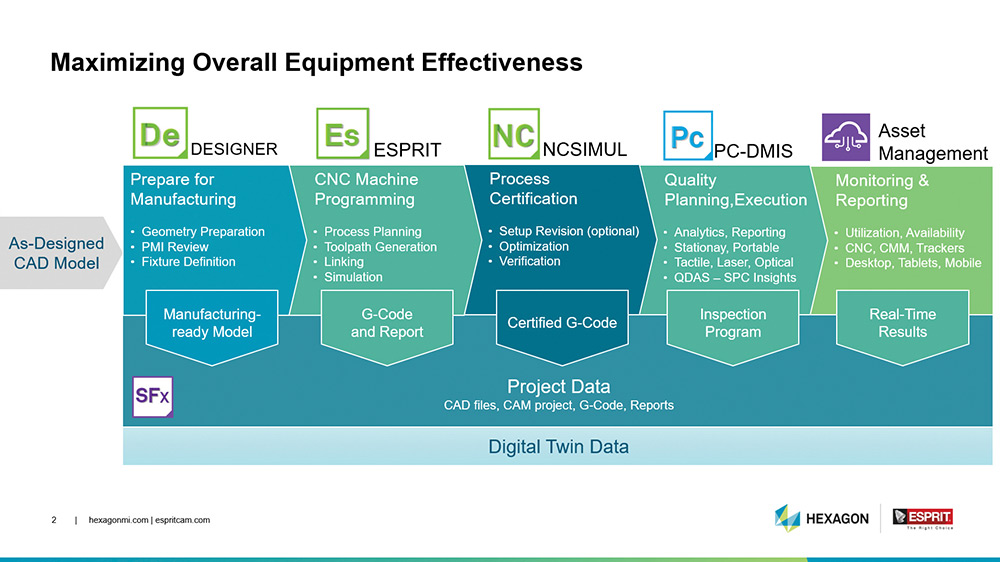
ME: Advanced capabilities like feature recognition can speed manufacturing. How are some of the newest ESPRIT CAM features, like the patent-pending machine-aware algorithms using digital twins, helping boost user productivity?
Mathews: ESPRIT’s machine-aware technology uses a digital twin of the machine, tooling, workholding and workpiece to provide efficiency in programming and shop floor operations. By producing higher quality G-code programs, machine setup times are shortened through reduction or elimination of program proveouts. This is a result of ESPRIT’s machine-aware program verification, which automatically ensures avoidance of collisions. With this technology, optimal rapid positioning between cuts is automatically calculated while the given CNC machine and its capabilities are considered. With an awareness of the machine, tooling and workpiece, ESPRIT’s ProfitMilling and ProfitTurning high-speed cutting cycles reduce cycle times up to 75 percent while improving tool life up to 500 percent by ensuring consistent loads on the cutters and optimizing the movements and speeds throughout the cut.
ME: Automation has vastly improved CAM functionality. Do you see any significant expansion of artificial intelligence (AI)-type functionality or any other automated features in CAM?
Mathews: We are clearly on a path towards autonomy with CNC programming and shop floor operations. This journey from assisted through automated, and ultimately towards autonomous programming and shop floor operations, will evolve over the coming years, most significantly due to the adoption of robotics and AI, including machine learning. Today, with our Intelligent Machine Control and Asset Management solutions, we are moving towards a closed-loop system where shop knowledge is captured and self-learning emerges. With ESPRIT, we have already seen advances with the AI Engine and Digital Twin for the automation of programming tasks, and our KnowledgeBase for capturing best practices. The adoption of AI within the CAM and CNC world will only accelerate in the coming years as the technology matures.
ME: How are the additive capabilities in ESPRIT CAM improving part-making capabilities?
Mathews: We use an agile software development methodology with a laser focus on delivering customer value via continuous software releases. The most visible, valuable and active area of our development is with digital machines and postprocessors in support of the latest CNC models and controls. We believe the industry should place more focus on the postprocessor because CAM systems that output high-quality, edit-free G-code pay dividends by simplifying programming and, most importantly, by improving overall CNC machine efficiency. We continually work on automating the workflow within the software on our journey towards autonomy, while also bringing significant advances to the software with new cutting cycles for the latest cutting tools and many other features that our customers consider valuable to their work.

ME: What changes has the 2020 merger with Hexagon brought about or will bring about to your ESPRIT CAM user base?
Mathews: ESPRIT is now part of a smart manufacturing portfolio that provides an end-to-end workflow for engineering, CNC programming and quality throughout shop floor operations. Our end-to-end workflow uses digital twins of shop floor assets and accurate representations of the real-world environment to provide context to the software with the aim of maximizing overall equipment efficiencies and shop floor operations. A digital thread runs through this workflow—from the as-designed CAD files to the CAM project and G-code programs, and ultimately the shop-floor results. This begins with using Product Manufacturing Information (PMI) within 3D CAD models to accelerate machine programming and quality planning, followed by real-time asset monitoring to help maximize overall equipment effectiveness (OEE). Starting with the as-designed CAD model, we use DESIGNER, our CAD-for-manufacturing solution, for geometry preparation, PMI review, and the design of any custom fixtures needed to hold the workpiece. The CAM programmer then uses the resulting manufacturing model within ESPRIT for CNC programming, toolpath generation, optimization and final program simulation and verification. Digital twins of machinery, tooling and workholding are central to connecting processes and providing the context for ESPRIT to fully utilize the productive potential of sophisticated, multi-channel machine tools. Optionally, G-code programs are certified using NCSIMUL for an additional level of security and confidence, for revisions to the setup, and further program optimization and verification. For quality planning, execution, reporting and analytics, we now offer software and hardware solutions, including PC-DMIS, Inspire and Q-DAS. Finally, our shop floor Asset Management solution is used to monitor and report on the utilization, availability and real-time status of shop floor equipment, including CNCs, CMMs and more. Building a digital thread that links processes from engineering to inspection entails eliminating the practice of working in silos in order to better share and fully utilize critical data.
ME: How has the CAD/CAM business been for ESPRIT, and what’s the forecast for next year?
Mathews: Onshoring is driving extraordinary growth for us and for our customers. We expect this growth to continue, driven by manufacturers striving to shorten their supply chain, produce higher quality products and, as a result, improved margins for the manufacturer.
Rockwell Automation to Acquire Plex Systems for $2.2 Billion
Industrial automation developer Rockwell Automation Inc., Milwaukee, and Troy, Mich.-based Plex Systems, developer of cloud-native smart manufacturing platforms, have entered into an agreement under which Rockwell will acquire Plex for $2.22 billion in cash. Plex, which offers a single-instance, multi-tenant SaaS manufacturing platform, including manufacturing execution systems and quality- and supply chain management capabilities, says it has more than 700 customers and manages more than 8 billion transactions daily. Plex will be reported as part of Rockwell’s Software and Control operating segment, which provides hardware and software offerings for the design, operation and maintenance of production automation and management systems. As part of the acquisition, Rockwell will welcome more than 500 new employees from Plex. The acquisition will be financed with a combination of cash and short-term and long-term debt. Subject to customary closing conditions and completion of regulatory review, the acquisition is expected to close in Rockwell’s fiscal fourth quarter.
Siemens Acquiring FORAN Software
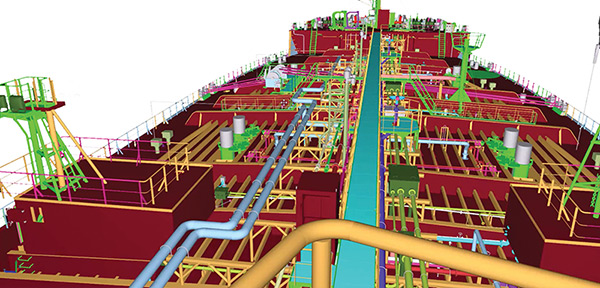
Siemens Digital Industries Software, Plano, Texas, has signed an agreement with Spain-based SENER, a multinational engineering and technology company, to acquire its FORAN software business. FORAN is CAD/CAE/CAM software for the design, construction and engineering of vessels and marine structures. The addition of the FORAN product and team to Siemens brings experience in complex commercial marine projects, defense industry standards and regulation compliance, Siemens said. SENER Group will keep its traditional marine engineering business line, where it offers design, engineering and consultancy services for different types of ships and offshore vessels. FORAN will be added to Siemens’ Xcelerator portfolio. Terms were not disclosed. The acquisition of FORAN is due to close in the fourth quarter of 2021.
Survey Shows Digital Acceleration in Supply Chain is Critical
A new study by ERP developer Epicor Software Corp., Austin, Texas, shows mid-size businesses are bullish on growth fueled by investments in cloud-ready technologies. The study, Epicor’s Insights Report, surveys leaders from mid-size businesses across the manufacturing, distribution and retail industries on the drivers of business growth over the coming year. The survey finds the nation’s most essential business leaders are not simply gearing up for a “bounce back” year but rather are leaning into the accelerating forces of COVID-19 to “leap forward.” The most significant indicator of progress is the radical swing in cloud adoption. In 2020, 25 percent of respondents declared cloud a strategic priority. In this year’s study, 99 percent of those surveyed confirmed they plan to move to the cloud, and 94 percent of them intend to do so this year. The full report can be accessed at epicor.com/industry, along with the summary fact sheet.
CNC Machining Centres Market 2022
Looking to the future of the CNC machining market? Consider this report.
According to MarketWatch:
Global “CNC Machining Centres Market” report offers sales growth rate comparison by type, segment by application, market effect factors analysis, size estimates, market competition by key manufacturers, competitive situation and upcoming trends. This market study provides the CNC Machining Centres supply chain analysis,growth opportunities, totalrevenue, recent development, keyrawmaterialsanalysis and COVID-19 impact is covered in this report.
The global CNC Machining Centres market is valued at million USD in 2020 is expected to reach million USD by the end of 2026, growing at a CAGR of % during 2021-2026.
Global CNC Machining Centres Market: Drivers and Restrains
The research report has incorporated the analysis of different factors that augment the marketâs growth. It constitutes trends, restraints, and drivers that transform the market in either a positive or negative manner. This section also provides the scope of different segments and applications that can potentially influence the market in the future. The detailed information is based on current trends and historic milestones. This section also provides an analysis of the volume of production about the global market and also about each type from 2015 to 2026. This section mentions the volume of production by region from 2015 to 2026. Pricing analysis is included in the report according to each type from the year 2015 to 2026, manufacturer from 2015 to 2020, region from 2015 to 2020, and global price from 2015 to 2026.
A thorough evaluation of the restrains included in the report portrays the contrast to drivers and gives room for strategic planning. Factors that overshadow the market growth are pivotal as they can be understood to devise different bends for getting hold of the lucrative opportunities that are present in the ever-growing market. Additionally, insights into market expertâs opinions have been taken to understand the market better.
List of Top Key Players in CNC Machining Centres Market Report Are: -
● Haas Automation
● Hurco
● Makino
● Okuma
● SMTCL Americas
● Yamazaki Mazak
● CMS North America
● Jyoti CNC Automation
● KRUDO Industrial
● Komatsu NTC
● Mitsubishi Electric
Global CNC Machining Centres Market: Regional Analysis
The CNC Machining Centres market is analysed and market size information is provided by regions (countries). The report includes country-wise and region-wise market size for the period 2015-2026. It also includes market size and forecast by Type and by Application segment in terms of sales and revenue for the period 2015-2026.
CNC Machining Centres Market Size by Types:
● CNC Lathe
● CNC Milling
● CNC Grinding
● CNC Welding
● CNC Winding
CNC Machining Centres Market Size by Applications:
● Machinery Manufacturing
● Automobiles
● Electronics
● Healthcare
● Aerospace and Defense
CNC Machining Centres Market report provides comprehensive analysis of
● Key market segments and sub-segments
● Evolving market trends and dynamics
● Changing supply and demand scenarios
● Quantifying CNC Machining Centres market opportunities through market sizing and market forecasting
● Tracking current trends/opportunities/challenges
● Competitive insights
● Opportunity mapping in terms of technological breakthroughs
This market study includes the global and regional market with an in-depth analysis of the overall growth opportunities in the market.
Some of the Key Questions Answered in this Report:
● CNC Machining Centres market report provides comprehensive analysis of the market with the help of up-to-date market opportunities, overview, outlook, challenges, trends, market dynamics, size and growth, competitive analysis, major competitors analysis.
● Report recognizes the key drivers of growth and challenges of the key industry players. Also, evaluates the future impact of the propellants and limits on the market.
● Uncovers potential demands in the CNC Machining Centres market.
● CNC Machining Centres market report provides in-depth analysis for changing competitive dynamics
● Provides information on the historical and current market size and the future potential of the market.
Geographical Regions covered in CNC Machining Centres market report are:
● North America (U.S. and Canada) Market size, Y-O-Y growth, Market Players Analysis and Opportunity Outlook
● Latin America (Brazil, Mexico, Argentina, Rest of Latin America) Market size, Y-O-Y growth and Market Players Analysis and Opportunity Outlook
● Europe (U.K., Germany, France, Italy, Spain, Hungary, Belgium, Netherlands and Luxembourg, NORDIC (Finland, Sweden, Norway, Denmark), Ireland, Switzerland, Austria, Poland, Turkey, Russia, Rest of Europe), Poland, Turkey, Russia, Rest of Europe) Market size, Y-O-Y Growth Market Players Analyse and Opportunity Outlook
● Asia-Pacific (China, India, Japan, South Korea, Singapore, Indonesia, Malaysia, Australia, New Zealand, Rest of Asia-Pacific) Market size, Y-O-Y growth and Market Players Analysis and Opportunity Outlook
